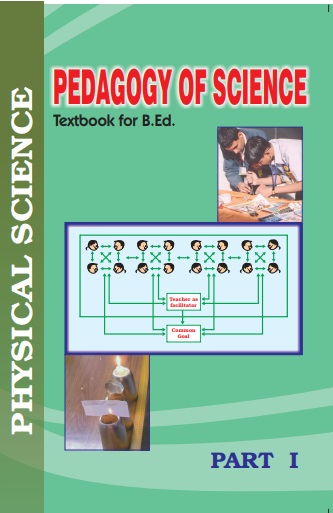Download Free NCERT e-Book "Pedagogy of Science: Physical Science Part-I - Textbook for B. Ed. Course"
Disclaimer: This website is NOT associated with CBSE, for official website of CBSE visit - www.cbse.gov.in

Download Free NCERT e-Book "Pedagogy of Science: Physical Science Part-I - Textbook for B. Ed. Course"
Contents:
PART I
1. nature of science 1
1.1 What is science? 1
1.2 Nature of science 2
1.3 Scientific method : A critical view 21
1.4 An illustration of how science works 24
1.5 Role of a science teacher 25
1.6 Summary 27
2. Science and Society 30
2.1 Introduction 30
2.2 Physical science and society 33
2.3 Role of the teacher 42
2.4 Contributions of some eminent scientists 43
2.5 Summary 48
3. Aims of Learning Physical Science 51
3.1 Introduction 52
3.2 Aims of learning Science 52
3.3 Knowledge and understanding through science 53
3.4 Nurturing process skills of science 54
3.5 Development of scientific attitude and scientific temper 57
3.6 Nurturing the natural curiosity, creativity and aesthetic sense 63
3.7 Relating physical science education to natural and social environment, technology and society 69
3.8 Imbibing the values through science teaching 72
3.9 Development of problem solving skills 74
3.10 Role of a science teacher 75
3.11 Summary 76
4. learning objective of physical science 78
4.1 Introduction 78
4.2 Meaning of learning objectives 79
4.3 Developing learning objectives 80
4.4 Anderson and Krathwohl’s taxonomy 84
4.5 Writing learning objectives 92
4.6 Illustrations on learning objectives for upper primary, secondary and higher secondary stages 99
4.7 Learning objectives in the constructivist perspective 102
4.8 Summary 106
5. Exploring Learners 108
5.1 Introduction 108
5.2 Each learner is unique 109
5.3 Motivating learners to bring their previous knowledge into classroom 111
5.4 Involving learners in teaching-learning process 116
5.5 Role of learners in negotiating and mediating learning in physical science 125
5.6 Encouraging learners to raise and ask questions 128
5.7 Encouraging learners to collect materials from local resources 134
5.8 Summary 138
6. School Curriculum in Physical Science 140
6.1 Introduction 140
6.2 History of development of curriculum framework 142
6.3 Curriculum framework, curriculum and syllabus 143
6.4 From subject-centered to behaviourist to constructivist
approach to curriculum development 149
6.5 Recommendations of NCFs on science curriculum 156
6.6 Trends of NCERT syllabi 158
6.7 Moving from textbook to teaching-learning materials 161
6.8 Teacher as curriculum developer 162
6.9 Summary 163
7. Pedagogical Shift in Physical Science 168
7.1 Introduction 168
7.2 Pedagogical shift from science as fixed body of knowledge
to the process of constructing knowledge 170
7.3 Democratising science learning: Critical pedagogy 187
7.4 Pedagogical shift: Planning teaching-learning experiences 189
7.5 Pedagogical shift: Inclusion 194
7.6 Summary 199
8. Approaches and Strategies for Learning Physical Science 202
8.1 Introduction 203
8.2 Scenario from 1950-1980 204
8.3 Post 1980 scenario 206
8.4 Approaches and strategies for learning physical Science 207
8.5 Constructivist approach 210
8.6 5E learning model 212
8.7 Collaborative Learning Approach (CLA) 214
8.8 Problem Solving Approach (PSA) 221
8.9 Concept mapping 229
8.10 Experiential learning 235
8.11 Cognitive conflict 238
8.12 Inquiry approach 242
8.13 Analogy strategy 244
8.14 Facilitating learners for self-study 245
8.15 Communication in science 250
8.16 Summary 255
9. Community Resources and Laboratory 259
9.1 Introduction 259
9.2 Learning resources from immediate environment 261
9.3 Using community resources 265
9.4 Pooling of learning resources 269
9.5 Improvisation of apparatus 271
9.6 Some inexpensive sources of chemicals 274
9.7 Science kits 276
9.8 Laboratory as a learning resource 279
9.9 Handling hurdles in utilisation of resources 296
9.10 Summary 299
Click Here to Download Full e-Book
Courtesy: NCERT